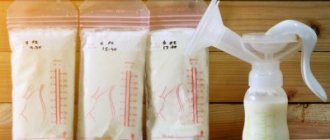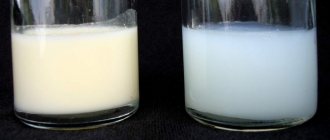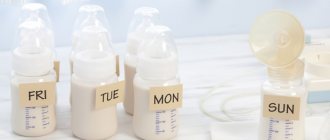It happens that a mother, for one reason or another, needs to temporarily stop feeding, but she does not want to completely wean the baby off the breast. Then she should find out how to freeze breast milk so that it does not lose its beneficial properties and does not spoil during storage.
Freezing breast milk is only necessary if it is stored for a long time. If the supplies will be used within the next few days, it is better to store them chilled in the refrigerator without resorting to freezing. This will allow you to retain more nutrients.
Which container to choose for storing supplies
It is important not only to follow all hygiene requirements, but also to choose the right storage container.
What is not recommended to do
It is convenient to store breast milk in glass bottles, but do not freeze breast milk, since temperature changes can cause the glass to crack. Glass containers are also bad because during the freezing process, valuable fat fractions stick to them, which the baby then does not get.
It is not recommended to use clear plastic containers made of polycarbonate. This type of material contains the dangerous substance Bisphenol A, which is released during heating and enters the product. If such a container is used for freezing, then it will not be possible to heat the product in it. To reheat, the thawed milk must be poured into another container. Dishes that do not contain Bisphenol A are marked “BPA free”.
How to use thawed breast milk
The main rule that pediatricians pay attention to is not to refreeze milk that has already been removed from the freezer. Once defrosted, it means either use it or dispose of it. There are no other options.
Doctors from ABM recommend giving your baby breast milk within 2 hours after it is completely defrosted. But in general, it can last another day in the refrigerator.
If you are late, be sure to check to see if the milk has spoiled. Most likely, during the defrosting process, the product will split into 2 phases - lighter fats will accumulate in the upper layer. The milk needs to be mixed gently. Do not shake the container! And then - if the milk is not at the right temperature for feeding the baby - it needs to be warmed up. It is better to do this either under warm running water or in a special heater-sterilizer.
Recommended Actions
For storage, you can choose opaque polypropylene containers, which are considered safe.
Frozen breast milk can be conveniently stored in special plastic bags. These bags fit compactly into the freezer. In addition, they are sold already sterilized, which simplifies their use. The bags can be connected to a breast pump, which reduces the chance of milk contamination when expressing.
Any utensils, with the exception of sterilized bags, must be washed and dried in advance.
How to express properly to collect milk for freezing?
This work can be done as quickly as possible using a breast pump. The process itself is short and less traumatic than expressing by hand. But there are women who find it more convenient to do this procedure manually. The chosen method does not affect the result in any way. How to freeze breast milk is also not a fundamental question - it depends on what is convenient for you.
The main thing is to wash your hands, sterilize storage utensils, if they are reusable (there are special sterile bags for collecting milk), and the breast pump itself. For sterilization, you can use a microwave or boiling. It is advisable to immediately express the milk into the container in which it will be stored. By following these simple steps, you can easily freeze breast milk. Reviews from mothers very convincingly prove that this is a very practical method.
Freezing expressed milk
In order for milk to be stored for a long time, it is necessary to protect it from unnecessary contact with air. Immediately after expressing, the container must be closed. Excess air is removed from plastic bags.
Containers or bags in which breast milk is supposed to be frozen should be no more than 3/4 full, since the liquid expands when frozen and a container filled to the brim may burst.
It is better to freeze stocks in small portions up to 120 ml, so that the entire amount of defrosted milk can be used at one time.
It is not recommended to refreeze milk, as this will destroy most of the vitamins. The milk must first be cooled in the refrigerator and only then put into the freezer.
If there is not enough milk to freeze, you can fill the container during the day and then freeze it. You can add fresh milk to the cooled portion if the amount is significantly smaller and does not heat up what has already cooled. Otherwise, it is better to cool the fresh one first in a separate container and then mix it with the already cooled one. You can add a little chilled food to the frozen one, avoiding thawing of the stored portion.
The breast pump and container must be pre-treated. Expressed milk does not require any processing before freezing.
Breast milk storage containers
Breastfeeding women should know what they can use to freeze breast milk and how best to store it. On pharmacy counters there are measuring cups or jars with convenient screw valves that measure a certain amount of milk. Milk can be stored in various containers: plastic cups, glass jars or freezer bags. Containers must be washed, cleaned and dried in advance (except for bags). It is not recommended to use polycarbonate containers, which contain harmful substances. Heating such cups is especially dangerous. The dishes are BPA free and marked with the “BPA free” logo.
Using packages
The container is not filled to the brim, but three-quarters, since the liquid increases many times due to freezing, which means that a container filled to the brim may burst. It is important that breast milk is frozen in a small volume - a maximum of 120 ml. This is a convenient dosage for one feeding. The baby will receive fresh food at every meal.
Repeated freezing is not advisable, because the next time it thaws, the beneficial substances are lost. The expressed amount of milk is left in the refrigerator and placed in the chamber no later than 24 hours after expressing. The woman decides for herself what is the best way to store the product.
There are disposable bags for freezing milk on sale. Before using the package, you must indicate the date and time of pumping. They save space, are sold already prepared - sterile, and are connected to a manual or electric breast pump, reducing the risk of milk contamination. A convenient clasp and measuring scale allow you to store, freeze and defrost the product without any problems. This storage option is cheaper than plastic containers. Breast milk should be defrosted in the same way as in any other container - first in the refrigerator, and then heated in a glass of warm water.
We recommend reading: Packages for freezing breast milk
Using special containers
Another type of breast milk storage has strong properties for freezing liquids. Special containers come with the breast pump. You cannot use containers that contain polyvinyl chloride or polycarbonate. Dangerous container markings: numbers 3, 7 or letters “BPA”. Conscientious manufacturers of food containers for the production of food storage containers use non-toxic polypropylene, marked with the number 5 or the abbreviation PP. If the container bursts, it should be replaced with a new one.
Using bottles
It is convenient to store milk in a glass container, but not to freeze it. Changes in temperature cause glass to burst, and at low degrees the fatty fractions of milk remain on the walls of the jar irrevocably.
The advantage of glass bottles and containers is the safety of the material, durability and ease of care. This type of storage is more expensive than its analogues. Baby puree jars are suitable for storing and freezing milk. The dishes are first washed and wiped dry, and the date and time of milk collection are also indicated. It is advisable to fill 75% of the jars.
Storage
Inventories should be stored without exceeding the following periods:
- in the general compartment of a refrigerator on a freezer shelf - up to 14 days;
- in a freezer with a separate door – up to 4 months;
- in a separate freezer with a constant temperature no higher than 200C - up to a year.
How long will milk actually last? It depends on how correctly it was collected from a hygienic point of view.
During freezing, expressed milk sometimes changes color. This does not affect the quality of the product in any way. If the milk does not smell sour, it means it has not spoiled.
Shelf life of milk
Storage conditions in the freezer are limited. The period should not exceed two weeks for the main chamber, and for a separate freezer located at the bottom of the refrigerator - up to five months. The free-standing chamber allows you to store breast milk for up to one year.
The shelf life of up to 25 degrees is up to six hours if the room becomes cooler by 3-6 degrees. The time increases to 10 hours. At 15 C and below, the liquid product is stored for 24 hours.
During storage of milk, a color change occurs. This does not affect the quality and properties of the product. Milk that does not emit a kefir smell is allowed to be used.
The container is located at the far wall of the refrigerator. Thawed milk is not re-frozen, but can be stored for another day in the refrigerator. A young mother must remove air from the container before closing the lid.
We recommend reading: Milk stagnation during breastfeeding
Cons of freezing
Freezing is not the best storage method. If all cleanliness conditions are met, chilled milk can be stored in the refrigerator for up to 8 days. Moreover, the number of harmful microorganisms in it decreases over time, since the enzymatic system of milk is included in the work.
If the product is frozen, then when it thaws it will lose about half of its valuable substances. But their content will be five times higher than in substitutes. However, if expressed milk is used several days in advance, it is best to store it refrigerated.
After thawing, a specific soapy smell sometimes appears. Some children refuse to drink this milk. The odor is caused by the enzyme lipase, which is inactivated by high temperature. If expressed milk is brought to the pasteurization temperature (600C) without allowing it to boil, the lipase will be destroyed, but some useful substances will also be lost - for example, vitamin C.
When frozen milk is stored in refrigerators and does not need to be defrosted, the fat composition of the product changes due to regular thawing and freezing.
Because of all these disadvantages, you need to think about how long you will actually have to store your expressed milk and whether it should be frozen.
How to defrost milk correctly to preserve all the beneficial substances in it?
If you plan to feed your child with prepared foods, then it is better to take out one container in advance and put it in the refrigerator so that thawing occurs gradually. If you don’t have time to wait, you can hold the bag or container under running warm water. Next, you need to bring the dish in a water bath to the desired temperature. Mother's milk has the same temperature as the body, so before feeding the baby, you need to check the degree of its heating on the wrist.
Warmed milk that the child has not finished should be thrown away; there is no point in storing it any longer.
You cannot use a microwave for heating, otherwise all your painstaking work on preparation and storage will go down the drain. Most useful substances will simply be destroyed by exposure to radio waves.
As the child grows up, his needs for the amount of different vitamins and microelements change, and the composition of the milk also changes. Therefore, the ideal option would be to quickly use the preparations so that the baby gets fresh portions. But if you managed to save a lot of milk until the time when normal feeding is no longer possible, then such reserves will be worth their weight in gold. No baby food can replace breastfeeding.
Defrosting
If it is not known how long it will take before the expressed milk is consumed, it is best to store it frozen.
It is important not only to freeze the product correctly, but also to defrost it with the least loss for the quality composition.
However long it takes, the milk should be thawed gradually. To defrost, you need to move it from the freezer to the refrigerator. Then you need to heat the thawed milk by placing the vessel in warm, but not hot water. Such gentle thawing will preserve beneficial substances to a greater extent.
You should not use a microwave for heating, since uneven heating provokes the destruction of beneficial substances.
If the entire defrosted portion is not used immediately, the leftovers can be stored in the refrigerator for no more than 24 hours.
Of course, in the first six months of life, breast milk remains the most valuable nutrition for the baby. But life circumstances sometimes make their own adjustments, and if the mother does not want to switch the baby to formula, then she has the opportunity to stock up on expressed milk.
Even pre-frozen breast milk will be much healthier for the baby than the highest quality substitute.
Why store breast milk when you can feed your baby fresh?
It would seem - here is the mother, here is the child. What problems can there be with feeding, what are these preparations for? But this need did not arise out of the blue; it was due to the experience of many mothers who had to face unusual situations. Now it’s difficult to say who was the first to think of freezing breast milk in a bottle, but many women successfully practice this experience. It is worth saying that it is not only frozen, but also simply stored in the refrigerator (for a very short time). Why is this necessary?
- Health problems. Nobody expects this, but it still happens sometimes. A nursing mother gets sick and has to take medications that may be unsafe for the baby. In this case, you can feed the child frozen food until health is restored.
- Long-term absence is a significant reason. An urgent business trip that cannot wait for the end of maternity leave, the need for treatment in a hospital, etc. There can be many reasons and you need to be prepared for such situations.
- Excess milk. It happens that a child does not need as much food as his mother can provide him with, and the excess simply pours out. When the lactation period ends, and this sometimes happens very unpredictably and unexpectedly, women think that they would like to feed the baby longer, but this is no longer possible. The problem is solved by those women who managed to think about freezing breast milk in time. How it should be stored and how to freeze it correctly are the main questions when storing milk for future use.
Defrost milk
How to defrost milk from the freezer
Defrosting milk from the freezer should be slow and gradual, not fast. For this reason, the easiest way to defrost milk is to simply transfer it from the freezer to the refrigerator. A slightly higher refrigerator temperature will allow the milk to thaw little by little.
How to defrost milk correctly
If you're in a hurry to properly defrost milk, try filling the sink or any large container with cold water (not hot) and submerging the container of frozen milk in it. Use a heavy object to hold the milk under water as it thaws. This process will be faster than defrosting milk in the refrigerator, but it still usually takes a few hours, so be patient.
Is it possible to defrost milk in the microwave?
Never try to defrost milk in the microwave! Quickly defrosting frozen milk by heating it is a sure-fire method for destroying the structure of the milk. Heating milk can cause uneven thawing or even scalding, leaving you with a very unappealing finished product. Below are just a few tips on how to avoid this situation:











